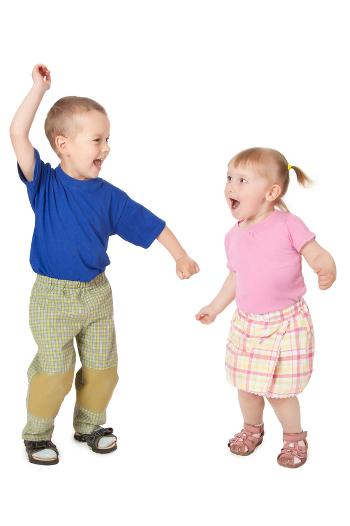Friday night dance party
Duration/age

Let's party!
Friday night could be party time at your house. First set the scene. Where will the dance party be? Do you need to move some furniture? Have you got music? Do you have some coloured lights?
Let’s move the chairs out of the way. They’re heavy so we’ll need to push hard.
Put the music on and dance with your children. Think of lots of ways to move and let the music guide you.
This is slow music. Let’s move slowly. Now it's jumpy and fast - so let's go!
Help your child to follow the beat of the music. You can clap, stamp your feet or use a drum.
Fast, fast, slow. 1, 2, 3, 4.
Encourage your child to use different parts of their body as they dance.
Can you make just your arms dance? Can you make spiky or curved shapes with your arms and legs?
Keep some scarves or pieces of fabric nearby for the dance party. Your child can include them in their dance or use them to make a costume.
Materials you will need
- Music
- Scarves or fabric
Alternative tools
- Drum
Skills this activity improves
Why does this matter?
When children dance they are learning about their bodies in space. As they move their hands up high or their bodies around the room they will be developing their spatial awareness – they will become aware of where their body is in relation to other objects and people.
As they listen to how fast, slow or jumpy the music is your child will be learning about beat and tempo and how to listen to details.
Dancing is a wonderful way for children to develop their motor skills. As they move they are building muscle strength and coordination.
What does this lead to?
Having good spatial awareness is important because it means you can move safely around your environment. It also leads to the ability to visualise or plan how to get from one place to another.
Listening is an important part of communication. Being able to listen to what others are saying is more than just hearing. It is also about actively listening and understanding.
Strong motor skills will help your child to move safely and be active. It also helps children to write more easily.
Language to use
- Dance, sing
- Fast, slow, quickly, slowly
- High, low
- Beat, rhythm, tap, drum
- Stomp, slide, sway
- Wiggle, wriggle, shimmer, shake
- Groove, move
- Spiky, curved, smooth, jumpy
Questions to use
- How high can you reach as you dance?
- Can you dance down low?
- How does that music make you feel?
Useful tips
- You might also like to take a look at the Let's dance activity.
- Remember to talk to your child in your home language.
More ideas
You might like to include a mirror ball to add to the atmosphere.
Variation by age
Birth to two year olds
- Babies love dancing too. Dance around the room holding your baby while you sing or listen to music.
- Sing moving songs you can dance to, like Rock-a-Bye-Baby.
Three to five year olds
- Dance and stop is another dancing game you can play with your children. Play the music and encourage them to dance wildly. Stop the music and get them to stop in the pose they were in.
- Have your own karaoke time. All you need is some music and something to sing into. Your child could use a hairbrush or make a microphone out of a cardboard cylinder.
- Sing moving songs you can dance to, like Hokey Pokey or If You’re Happy and You Know It.
Questions to ask
- Can you hear the music? It’s so soft and gentle.
Questions to ask
- Can you make a shape when the music stops?
- What’s your favourite song to sing?
Language to use
- Dance, sway
Language to use
- Dance, stop, freeze
- Pose, shape
- Sing, rap, song, perform, microphone


